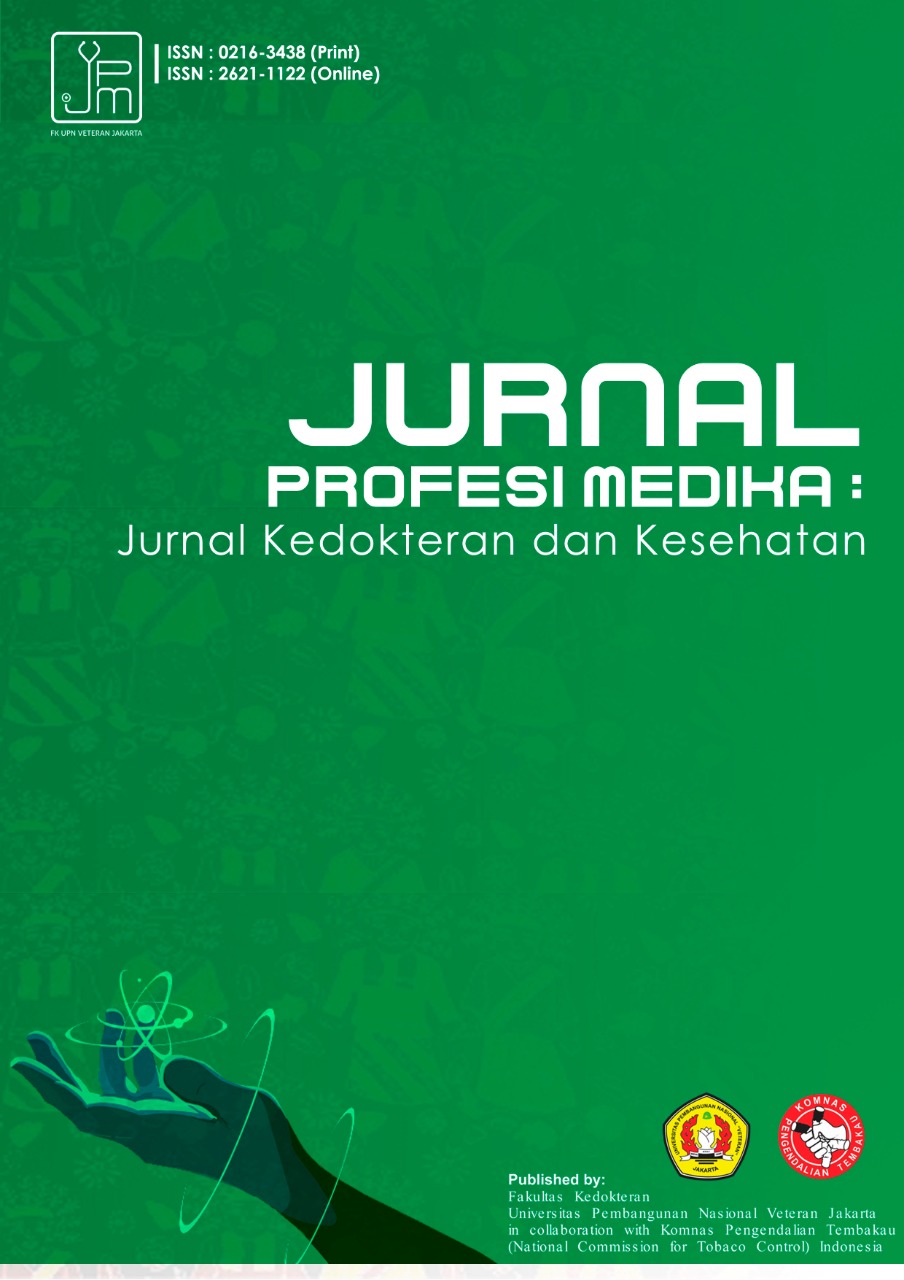Ferritin Level as Independent Predictor of Covid-19 : a Cross Sectional Study
DOI:
https://doi.org/10.33533/jpm.v16i1.4183Keywords:
COVID-19, Ferittin Serum, SeverityAbstract
COVID-19 is an infectious disease caused by SARS-CoV-2. In severe cases of COVID-19, it is often accompanied by a syndrome known as cytokine storm or cytokine release syndrome (CRS). Serum ferritin levels, increase as the disease worsens. This study aims to see the relationship between ferritin levels and the degree of COVID-19 and evaluate ferritin levels as a predictor of severity in COVID-19 patients at RSPI Prof Dr Sulianti Saroso. This type of research is quantitative with a cross sectional approach. Data analysis using Kruskal Wallis test. Secondary data from medical records of confirmed COVID-19 patients based on the results of PCR examinations during March 2020 to December 2020 who examined ferrittin levels as many as 554 patients. The results showed that the average ferritin level was 164.78, moderate was 524.13, severe was 1377.52 and critical was 1592.46. The results of the analysis with the Kruskal Wallis test obtained P value = 0.000 < (0.05) so it can be explained that there are differences in ferritin levels of the four degrees of disease. This shows that there is an effect of the relationship between ferritin levels and the degree of disease in COVID-19 patients.
References
Kemenkes RI. Pedoman Pencegahan dan Pengendalian Corona Virus deases (Covid-19). Kementrian Kesehat Republik Indones [Internet]. 2020;5:178. Available from: https://covid19.go.id/storage/app/media/Protokol/REV-05_Pedoman_P2_COVID-19_13_Juli_2020.pdf
Huang C, Wang Y, Li X, Ren L, Zhao J, Hu Y, et al. Clinical features of patients infected with 2019 novel coronavirus in Wuhan, China. Lancet [Internet]. 2020 Feb 15;395(10223):497–506. Available from: https://doi.org/10.1016/S0140-6736(20)30183-5
Cheng L, Li H, Li L, Liu C, Yan S, Chen H, et al. Ferritin in the coronavirus disease 2019 (COVID-19): A systematic review and meta-analysis. Vol. 34, Journal of Clinical Laboratory Analysis. 2020.
Alipour R, Hashemi SH, Mikaeili F. Serum iron level in patients with COVID-19: a case report study. Int J Res Med Sci. 2020;8(7):2658.
Zhou C, Chen Y, Ji Y, He X, Xue D. Increased Serum Levels of Hepcidin and Ferritin Are Associated with Severity of COVID-19. Med Sci Monit Int Med J Exp Clin Res. 2020 Sep;26:e926178.
Mohammedsaeed W, M. Surrati A, Q. Alnakhli H, Alharbi M, Syeed N. Alteration of Ferritin Levels and Lymphocytes Counts in Saudi Patients with COVID-19 Infection in Al Madinah Al Munawarah. Int J Diabetes Endocrinol. 2020;5(4):61.
Bozkurt FT, Tercan M, Patmano G, Bingol Tanrıverdi T, Demir HA, Yurekli UF. Can Ferritin Levels Predict the Severity of Illness in Patients With COVID-19? Cureus. 2021 Jan;13(1):e12832.
Ariza R, Messah AD, Sinaga F, Wahyudi A, Pratama SA, Annisa I. Korelasi Gambaran Radiografi Toraks dengan Karakteristik Klinis Pasien Terkonfirmasi Covid-19. Arter J Ilmu Kesehat. 2021;2(1):15–22.
Rajanna AH, Krishnegowda R, Govindaiah RM. To Correlate Serum Ferritin Levels with Clinical Outcome in Covid-19 Patients. Asian J Med Sci. 2021;12(5):25–9.
Kemenkes RI. COVID-19 INDONESIA Per 16 Mei 2021. INFEKSI EMERGING Media Inf Resmi Terkini Penyakit Infeksi Emerg [Internet]. 2021; Available from: https://infeksiemerging.kemkes.go.id/ dashboard/covid-19.
Satuan Satgas Penanganan COVID-19. Analisa Data COVID-19 Indonesia [Internet]. 2020. Available from: https://covid19.go.id/storage/app/media/Analisis Data COVID-19 Indonesia/2021/Januari/Analisis Data COVID-19 Mingguan Satuan Tugas PC19 per 03 Januari 2021 vFinal_compressed.pdf
Kangdra WY. Karakteristik Klinis Dan Faktor Komorbid Pada Pasien Dalam Pengawasan (PDP) Coronavirus Disease 2019 (COVID-19) di RS Mitra Medika Amplas [Internet]. Medan : Universitas Sumatra Utara; 2021. Available from: http://repositori.usu.ac.id/handle/123456789/30672
Zhang B, Zhou X, Qiu Y, Song Y, Feng F, Feng J, et al. Clinical characteristics of 82 cases of death from COVID-19. PLoS One [Internet]. 2020;15(7):1–13. Available from: https://doi.org/10.1371/journal.pone.0235458
Wang W, Knovich MA, Coffman LG, Torti FM, Torti S V. Serum ferritin: Past, present and future. Biochim Biophys Acta. 2020 Aug;1800(8):760–9.
Bozkurt FT, Tercan M, Patmano G, Bingol Tanrıverdi T, Demir HA, Yurekli UF. Can Ferritin Levels Predict the Severity of Illness in Patients With COVID-19? Cureus. 2021;13(1):1–8.
Al Meani SAL, Abdulkareem AH, Ibrahim MO, Ahmed MM, Mukhlif MY. Assessment the Correlation of D-dimer and Ferritin Level in Patients Infected with Covid-19 in Anbar Governorate of Iraq. Syst Rev Pharm. 2020;11(9):1130–3.
Nurin F. Mengenal Ferritin, Protein Penentu Kadar Zat Besi dalam Tubuh. Hello Sehat [Internet]. 2020. Available from: https://hellosehat.com/kelainan-darah/anemia/pemeriksaan-ferritin/
Nurin F. Mengenal Ferritin, Protein Penentu Kadar Zat Besi dalam Tubuh. Hello sehat. 2020 Oct;
Ramadan HKA, Mahmoud MA, Zakaria M, Aburahma, Elkhawaga AA, El-Mokhtar MA, et al. Predictors of severity and co-infection resistance profile in COVID-19 patients: First report from upper Egypt. Infect Drug Resist. 2020;13:3409–22.
Ahmed S, Ansar Ahmed Z, Siddiqui I, Haroon Rashid N, Mansoor M, Jafri L. Evaluation of serum ferritin for prediction of severity and mortality in COVID-19- A cross sectional study. Ann Med Surg. 2021;63(January).
Kernan KF, Carcillo JA. Hyperferritinemia and inflammation. Int Immunol. 2017 Nov;29(9):401–9.
Downloads
Additional Files
Published
How to Cite
Issue
Section
License
Copyright Notice
All articles submitted by the author and published in the Jurnal Profesi Medika : Jurnal Kedokteran dan Kesehatan, are fully copyrighted by the publication of Jurnal Profesi Medika : Jurnal Kedokteran dan Kesehatan under the Creative Commons Attribution-NonCommercial 4.0 International License by technically filling out the copyright transfer agreement and sending it to the publisher
Note :
The author can include in separate contractual arrangements for the non-exclusive distribution of rich versions of journal publications (for example: posting them to an institutional repository or publishing them in a book), with the acknowledgment of their initial publication in this journal.
Authors are permitted and encouraged to post their work online (for example: in an institutional repository or on their website) before and during the submission process because it can lead to productive exchanges, as well as earlier and more powerful citations of published works. (See Open Access Effects).






